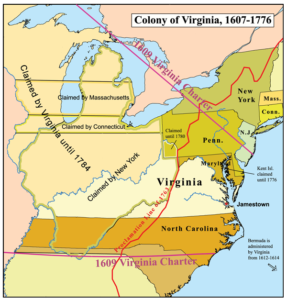Tom and I like the smaller, historical parks where we can do living history. Fort Necessity tells the story of young George Washington leading a company of Virginia milita into the western wilderness and starting the French and Indian War in 1754. I don’t want to overwhelm you with history lessons, so I will dish it out in pieces. Tom and I, of course, are currently immersed in learning everything we can about the park as quickly as we can. Here is lesson one in the history of Fort Necessity: The Ohio Company of Virginia.

The colony of Virginia was chartered by King James 1 in 1606, making it the first colony of the future United States. As the colony grew and gained power, it claimed huge swaths of land in the wilderness. Ohio, Indiana, Illinois, Kentucky, and West Virginia were all carved from land claimed by Virginia. Southwestern Pennsylvania was also part of the land claimed by Virginia.
In 1748, eight powerful Virginians formed the Ohio Company of Virginia. These men included the governor of Virginia, Robert Dinwiddie, and Lawrence and Augustine Washington, George Washington’s older half-brothers. (George inherited Mount Vernon from Lawrence when Lawrence died without heir when he was 34.) In 1749, King George I granted the Ohio Company 500,000 acres in the Ohio Valley between the Kanawha River and the Monongahela. The grant was in two parts: the first 200,000 acres were given. The Ohio Company had to successfully settle one hundred families within seven years. Then the second grant of 300,000 acres would be given. Furthermore, the Ohio Company was required to construct a fort and provide a garrison to protect the settlement at their own expense.
The Ohio Company began recruiting settlers and selling them land. But these isolated settlers soon reported that the French were coming down the lakes and rivers from Quebec and doing business with the Native Americans in the area. The Ohio Company recruited the young George Washington, with a small band of scouts and soldiers, to go and tell the French they were on British land.
 Excited by this task, George headed west in December of 1753. He was only 21 years old and this seemed like an adventure of the highest order. He loved blazing a trail in the wilderness. George met his first Native Americans, although he refused to take their advice on approaching the French. The Iroquois chief in the area, Tanacharison, hated the French, and went with George.
Excited by this task, George headed west in December of 1753. He was only 21 years old and this seemed like an adventure of the highest order. He loved blazing a trail in the wilderness. George met his first Native Americans, although he refused to take their advice on approaching the French. The Iroquois chief in the area, Tanacharison, hated the French, and went with George.
Washington met the French at Fort Le Boeuf and told them to leave the area. The French, unimpressed by the brash young man, refused. And George returned to Virginia to relay the message to Governor Dinwiddie.
Tomorrow Lesson 2: Jumonville Glen.
